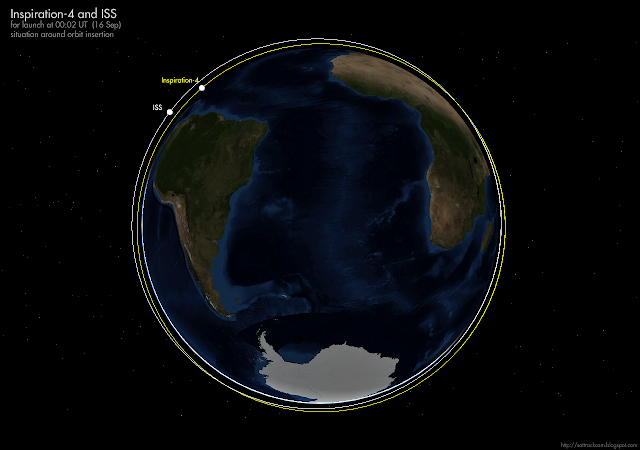 |
| click to enlarge |
Yesterday 27 September 2021 at 18:12 UT, Landsat 9 was launched from Vandenberg with a ULA Atlas V rocket.
2h 58m after the launch, after 1.5 revolutions and while over the east coast of the United Kingdom, the Centaur upper stage performed its deorbit burn, lowering perigee such that half an orbit later it would reenter over a designated area in the Pacific Ocean at the end of the second revolution. Following the deorbit burn, there was a fuel blow-out.
 |
| click map to enlarge |
The deorbit burn and fuel blowout happened within minutes of shadow exit over NW Europe. When the resulting exhaust and fuel clouds came into sunlight, they caused a bright spectacle in the sky that was widely seen around 21:12 UT (23:12 CEST) from a.o. the Netherlands, the UK, Belgium, France and Scandinavia.
The event was anticipated: already before the launch, Cees Bassa had noted that the time of the burn coincided with a pass over NW Europe and alerted observers on the Satobs list. I then put out additional alerts on a.o. Twitter, and as a result, many people observed it.
In addition, there were hundreds of unexpecting casual eyewitnesses, who often had no clue as to what they were seeing. One of the Dutch "UFO"-reporting sites got over 150 reports of a "UFO" in the northern sky as a result.
As seen from my hometown Leiden in the Netherlands, shadow exit would occur low in the northern sky, in Ursa Major. I had put up my camera opposite the historic Leiden Observatory in the center of Leiden, hoping to capture it over the telescope domes.
As it happened, the actual sky trajectory was slightly more eastwards in the sky than we had anticipated based on a pre-launch TLE estimate (my estimate placed in in the tail of the Big Dipper, while in reality it was in the bowl of the Big Dipper). Just enough to place it outside the FOV of my camera (and initially behind a tree).
So when it became visible and I realized it was off the predictions, I quickly grabbed the tripod and repositioned it. This made me photographically miss the first 20 seconds or so of the event. Over slightly more than 1 minute, I managed to shoot 50 images of the exhaust and fuel clouds descending over the roof of one of the Observatory's auxilliary buildings.
I was lucky with the clouds too. Fields of cumulus were drifting across the sky, and the relevant part of the sky had been clouded out only minutes before the observation (the clouds leaving the scene are visible in the photographs and time-lapse below).
The event was downright spectacular: two v-shaped, comet-like clouds, one very bright and one fainter (see images) with the tips upward, moving down in the sky among the stars of Ursa Major. The brighter, trailing one of the two clouds was easily visible, and of negative magnitude (mag -4 perhaps, as a rough estimate). It's shape changed over time, with a shell-like structure moving away from the tip. Very spectacular!
The fainter cloud is probably rocket engine exhaust from the brief deorbit burn. The brighter cloud is a cloud of fuel particles, resulting from the blow-out (depressurization) of the Centaur's fuel tanks after the burn (this is a.o. done to avoid fuel remnants exploding). Both clouds are illuminated by the sun, which is why they are visible.
Here are some of the 50 images I shot
 |
| click images to enlarge |
In two consecutive of the 50 images, an object briefly becomes visible between the fuel and exhaust clouds (arrow): it is not clear what this exactly is, as one would not expect the Centaur itself in this position (rather, at the tip of the bright cloud).
 |
| click to enlarge |
Below is a time-lapse movie I constructed from the 50 images. It is at 13 times the real speed: the series of images from which the movie was made spans slightly over 1 minute in time:
The event happened somewhere between ~550 and 685 km altitude, over the United Kingdom and North Sea. An exact altitude cannot be given at the moment: landsat 9 was delivered to a ~685 km orbit, but the rocket made additional manoeuvres, while releasing cubesats.
I have always wanted to see an event like this, and now finally have (my 51 degree North NW European location does not see this kind of events often). Still on my list: a real reentry.
(all the images shown here were made with a Canon EOS 80D camera and EF 2.0/35 mm lens, at 1-second exposure at ISO 2500).














